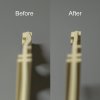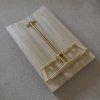Okay, jumping in! My Randy Cooper ISD Version 2 kit arrived a couple weeks ago and I've been slowly working up to getting going on it.
I made a bit of actual progress today so I thought I'd start a build thread to document as I start out on this long journey. It's going to be a long process with spurts of progress and some periods with a lot of time between posts, but I love watching other folks' build threads and I'm hoping that if anyone else is building this kit here that we can help each other along at times.
First order of business, of course, is just to lay everything out and inventory parts.


Everything looks to be in very good shape, with no significant issues (nothing broken, no serious casting flaws, etc.). It really is a beautiful kit with wonderful detail.
Common in resin kits (so I hear, this is my very first one!) is a little warping of some parts here and there. I saw that 3 of the 4 inner frame pieces had a little wiggle/warp here and there. Since the inner framework will be my first assembly I decided to do what I could to straighten them out, since I didn't want to take the chance that the slight warping in those pieces might propagate into some significant structural misalignment later on as I start to attach everything to it. Randy recommends just warming the pieces in boiling water to soften them up a bit and then cooling them while held in the proper shape. Since these pieces are large and flat I used a large no-stick baking tray on the stove top:

Straight out of the water I placed the pieces on some small wooden blocks that I cut to fit the flat areas of each frame piece between the connect points for the bracing between frames:


Worked like a charm and all the frame pieces are now nice and straight, so everything ought to line up nicely:

There is some remnant sprue here and there on a couple pieces, so the next step is the belt sander to clean those up...


Dan
I made a bit of actual progress today so I thought I'd start a build thread to document as I start out on this long journey. It's going to be a long process with spurts of progress and some periods with a lot of time between posts, but I love watching other folks' build threads and I'm hoping that if anyone else is building this kit here that we can help each other along at times.
First order of business, of course, is just to lay everything out and inventory parts.


Everything looks to be in very good shape, with no significant issues (nothing broken, no serious casting flaws, etc.). It really is a beautiful kit with wonderful detail.
Common in resin kits (so I hear, this is my very first one!) is a little warping of some parts here and there. I saw that 3 of the 4 inner frame pieces had a little wiggle/warp here and there. Since the inner framework will be my first assembly I decided to do what I could to straighten them out, since I didn't want to take the chance that the slight warping in those pieces might propagate into some significant structural misalignment later on as I start to attach everything to it. Randy recommends just warming the pieces in boiling water to soften them up a bit and then cooling them while held in the proper shape. Since these pieces are large and flat I used a large no-stick baking tray on the stove top:

Straight out of the water I placed the pieces on some small wooden blocks that I cut to fit the flat areas of each frame piece between the connect points for the bracing between frames:


Worked like a charm and all the frame pieces are now nice and straight, so everything ought to line up nicely:

There is some remnant sprue here and there on a couple pieces, so the next step is the belt sander to clean those up...


Dan
Last edited:




















